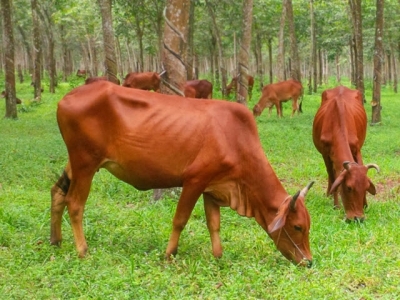Yeast strains may offer potential as feed additives in face of mycotoxin, pathogen presence

Some yeast strains may offer benefit as a feed additive when pathogens or mycotoxins are present in feed, say researchers.
An international team of researchers from Brazil and Argentina explored the use of different strains of S. cerevisiae isolated from bakery by-products to offer probiotic and anti-mycotoxin effects for use in animal feed, said the researchers. The group published its work in the journal of Food and Chemical Toxicology
“Although in the literature the joint ability of yeasts to be probiotic and adsorbent of mycotoxins has been reported, no study has shown these properties associated with the replacement of antibiotics,” the researchers said. “The aim of this study was to select S. cerevisiae strains able to exert probiotic and anti-mycotoxin effects plus antibiotics resistance properties for use in animal production.”
The viable cell counts in the yeast strains were altered by exposure over time to acids, the researchers said. But they tolerated the gastrointestinal (GI) conditions examined and provided some probiotic properties.
“The S. cerevisiae strains LL74 and LL83 were resistant to the antibiotics frequently used in animal production, tolerate the in vitro GI conditions passage, have some probiotic properties, and were capable of binding AFB1 [aflatoxin B1], making them a promising alternative for the development of new additives and probiotic action of mycotoxin decontamination,” they said. “These strains have potential application to be used as a biological method in animal feed as antibiotic therapy replacement in, reducing the adverse effects of AFB1 and giving probiotic properties.”
Why fermented yeast?
The role of functional food or functional supplements is increasingly of interest in animal production, said the researchers. The idea behind the concept is that digestibility and nutrient absorption are important for animal health.
These elements interact with intestinal mucosa and microbiota and functional supplements may offer a way to keep more beneficial microbiota alive, they said. “The yeast Saccharomyces cerevisiae can be used as functional supplement because it provides vitamins and amino acids, and has the potential use as probiotic,” they added.
Currently, producers are looking for natural feed additives to support animal health, and offer an alternative to growth-promoting antibiotics, they said. Alternatives may include live yeasts and yeast cell wall supplements derived from S. cerevisiae.
Several low cost by-products form the food industry can be used to generate food grade yeast biomass for use in animal feed, they said.
Aflatoxins, however, are a toxic element produced by some types of fungi and that impair feed quality, the researchers said. “The contamination of feed in livestock, with mycotoxins impairs animal health, welfare, and productivity, causing economic important losses,” they added.
Previous work has demonstrated the ability of S cerevisiae to bind some mycotoxins including aflatoxin B1 (AFB1) in gastrointestinal conditions, they said. These strains also have been linked to beneficial properties.
Additionally the antibiotic resistance displayed by yeast is considered a “desirable feature,” as it can act as a probiotic when antibiotics are administered to an animal to address the presence of a bacterial pathogen.
Methods and materials
In the yeast assessment, two strains of yeast derived from bakery by-products intended for use in animal feed were examined, the researchers said. The strains used were S. cerevisiae LL74 and S. cerevisiae LL83 strains.
The yeasts were examined for phenotypic characteristics and nutritional profile, they said.
Antimicrobials often used to treat animal disease were added to growth plates that included the yeast strains and growth response was measured, they said. The yeast strains also were tested on plates where a pathogenic bacteria strain was introduced.
“After 24 h incubation, antagonistic effect was determined by the appearance of clear zones surrounding the junctions of the streak lines, which indicated the inhibitory effect of one organism on the other,” they added.
Yeast tolerance to acids and bile was checked, said the researchers. The strains also were evaluated for performance in simulated gastrointestinal digestion conditions, and for their ability to co-aggregate in locations with bacterial pathogens that affect animals.
Yeast performance also was tested against the presence of mycotoxins, they said.
Results
Both yeast strains survived the use of antibiotics common to animal production, said the researchers. They were able to maintain viable cell counts through 24 hours of exposure to both acidic conditions and bile.
Similarly, both strains were able to demonstrate survival through a simulated salivary conditions and passage through the gastrointestinal tract, they said. However, the strains demonstrated low ability to block growth of some pathogens.
“The S. cerevisiae LL74 strain was able to co-aggregate with all pathogenic bacterial strains tested except with E. coli,” they said. “The degree of co-aggregation was greater for Proteus sp. and Shigella sp. strains. S. cerevisiae LL83 strain was able to co-aggregate with all pathogenic bacterial strains tested, obtaining the best results of co-aggregation with Proteus sp. and Salmonella sp. strains.”
Of the two strains, the s cerevisiae LL83 strain had a higher adsorption ability for mycotoxins, they said. But both could adsorb AFB1.
“Selected S. cerevisiae LL74 and S. cerevisiae LL83 have potential application to be used as a biological method in animal feed as antibiotic therapy replacement in, reducing the adverse effects of AFB1 and giving probiotic properties,” said the researchers.
However, more work is needed to assess the strains in an in vivo study, they said.
Related news
 Cattle could benefit from enzyme boost, says study
Cattle could benefit from enzyme boost, says study The use of exogenous enzyme supplementation has been shown to improve feed efficiency, support beneficial microflora and suppress pathogens
 Essential oils in feed improve meat quality: study
Essential oils in feed improve meat quality: study Use of clove and rosemary essential oils with encapsulated active principles in feed may reduce oxidation of meat and improve shelf life, say researchers.
 Is tree bark the remedy for diarrhea in calves?
Is tree bark the remedy for diarrhea in calves? A botanical extract may improve calf hydration and limit diarrhea, says researcher.